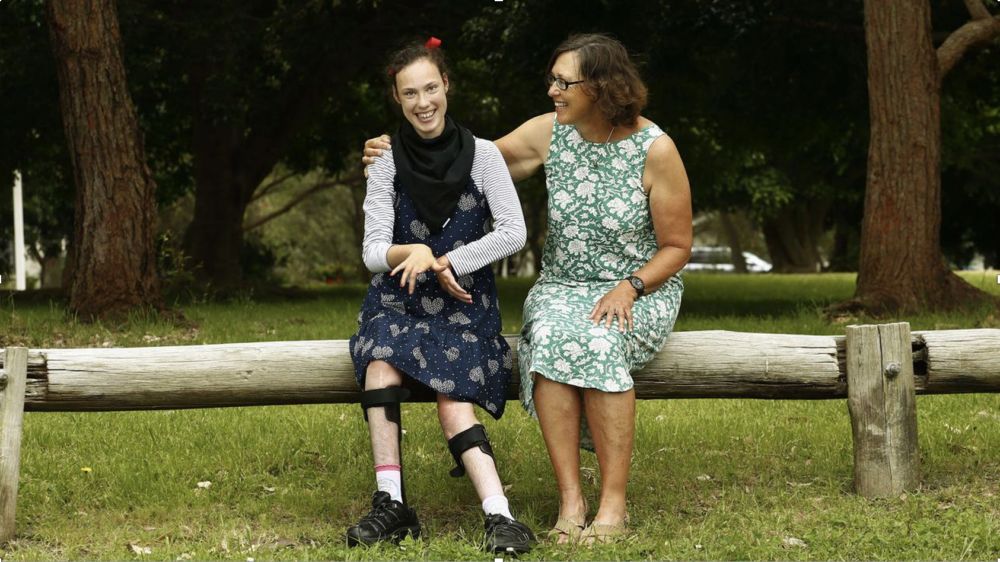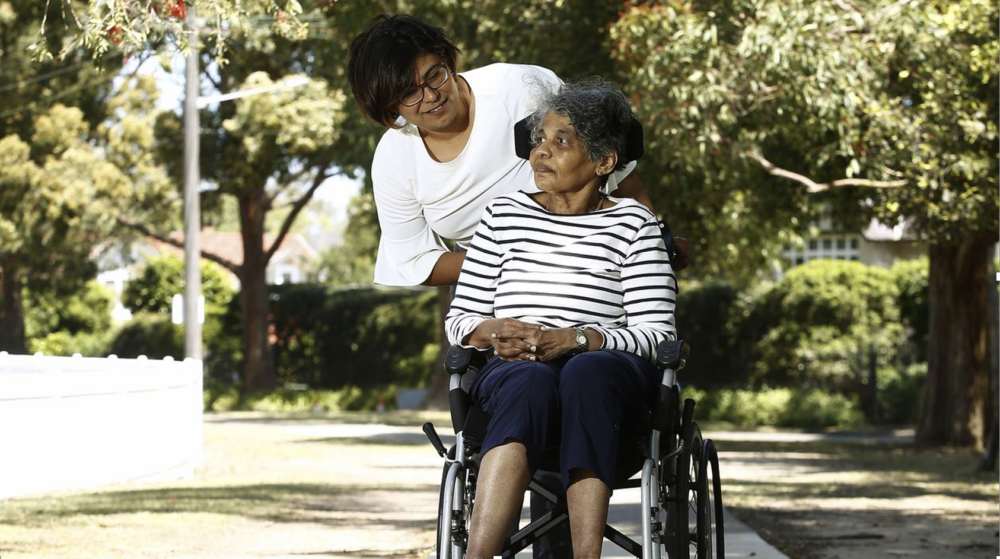Sometimes there’s an overlap between Good Grief! and the other newspaper articles I write and today’s story published in The Daily Telegraph, Mosman Daily, North Shore Times and The Wentworth Courier is a good example. Behind every dying person there’s usually at least one dedicated carer – often a whole family, with several sharing the responsibilities.
In this article the carers are not caring for someone who is dying, rather those who are chronically ill, elderly or live with a disability. But the principle is the same. The idea behind the article is to highlight the good work done by carers, show their value to the whole community and show their positivity.
We often minimise the work involved in high care, to protect the dignity of the person we care for – and our own. But we need to make realistic assessments of what’s involved and share that knowledge openly – the way Tania does.
That way, everyone’s lot improves, the work earns the respect it deserves and the truths of our lives are not hidden in a back cupboard, to be misunderstood, dismissed or distorted. Here is the story.
If you don’t have a subscription, you won’t be able to open it, so I’ve popped it here.

Selfless work of local carers worth billions*
*Reproduced from The Daily Telegraph, December 2, 2021.
Informal carers are in it for love, not money, and offer a service of immeasurable value to their families for free.
It’s a role defined by love, which explains why the value of informal, unpaid carers is impossible to measure. Statistics give only a glimpse of the story, since the values that underpin their work are also the gossamer veil that covers the whole endeavour.
But last year’s The Value of Informal Care in 2020, a report by Deloitte Access Economics, provides some valuable insights.
“In 2020 it is estimated that there are almost 2.8 million informal carers, comprised of around 906,000 primary carers in Australia,” Deloitte says.
The balance are 1.9 million part-time and regular occasional unpaid carers. The total cost to the Australian economy of replacing all these people would be $77.9bn, Deloitte says.
Most full-time cares are women – 70 per cent
Most full-time carers are women – 70 per cent – the majority between the ages of 45 and 65 – a time when, if not for the caring role, they would be establishing their own financial security.
Full-time informal carers typically do about 35 hours a week, usually for family members or close connections who are elderly or living with disability. They help with mobility, self-care and communication. Often, they live in to ensure the person’s safety and comfort – experiencing broken sleep themselves.
By this definition, Jaye Chadwick is the informal carer for her youngest child Kate, now 22, who was diagnosed with cerebral palsy and other disabilities when she was only five months old.
Two years ago Kate moved out of home, into a group house only a few suburbs away. Jaye still sees Kate every day, but relied on FaceTime during lockdowns – taking sometimes 26 calls a day from Kate. The caring role continues.
There were tears when Kate was first diagnosed – brutally documented over the phone by a paediatrician. Distraught, Jaye struggled to school to collect Kate’s siblings.
“It was the kindergarten teacher who, when I explained, looked at Kate and said: ‘Disregard what he said. Kate’s going to bring you so much joy.’ And she has.”
Jaye was glad when the NDIS began to roll out in 2016. It has had its critics and teething difficulties but to Jaye it’s a godsend, dignifying experiences that before were dehumanised.
“Before the NDIS you waited weeks at a time for respite or other services. You had no choices. Block funding was distributed according to formulas that didn’t relate to the person with the disability.”

Businesses, such as Danielle Robertson’s, have responded to the change in modelling. In 2016 she set up DR Care Solutions, tailoring care options for clients, organising packages for businesses supporting employees with care responsibilities and providing advice about the sector.
It services people in the aged care system too, which has undergone its own transformations, resulting in the government-funded My Aged Care. Today, Danielle’s business operates all over Sydney, including the north shore and eastern suburbs.
Danielle is full of praise for unpaid carers – always the ones orchestrating the care her service provides: “I’m inspired by their dedication, resilience, empathy to serve others before themselves … Many struggle to keep their loved one at home until it takes a toll on their own health. If the carer becomes unwell, we have two people requiring care.”
A new generation of entrepreneurs is leaping into the care space
A new generation of entrepreneurs is leaping into the care space, such as siblings Jordan and Laura O’Reilly. Their Fighting Chance program, inspired by their late brother Shane, provides social programs and work opportunities for people living with disabilities. It generated $19.8m in revenue last year.
Their newer ‘impact economy’ business, aiming to create social change through multi-sided platforms, is Hireup. With 750,000 clients and support workers, it’s the largest online network of supporters in Australia and this year raised $40m, partnering with Seek.
Deloitte defines part-time and occasional carers as people who do at least five hours of informal care a week. Jonathan Toblib of Rose Bay fits into this category. He and his two sisters each spend at least two hours every second day caring for their parents in Bondi.
The frail, elderly couple couldn’t live independently without the care provided by the three siblings. Jonathan’s father has a range of illnesses including blindness. His mother suffered a broken neck, at the C2 vertebra, several years ago that causes chronic pain.
“My mother is my father’s eyes and my father is my mother’s hands,” said Jonathan.
Jonathan retired a year ago, which gives him more time to be with them: “My father lives in a world of darkness so I wouldn’t stop, but I genuinely enjoy seeing them. We all get on and it’s the way we were brought up, with family values. But ultimately it’s about love.”
NSW government research shows the earnings of carers are 42 per cent lower than those of non-carers. And it’s a role with low social status, but this doesn’t worry Tania Teague, who splits her time between Centennial Park and Killara, where she cares for her mother, Anita, who has spinocerebellar ataxia type 2.
“We considered the alternatives, such as Mum going into permanent care or us having more paid support, but we had to ask: ‘Is that the right thing for us?’ It wasn’t,” Tania says. “I was lucky, I was 36 when I took on the role, six years ago, so I already had a strong sense of self definition.”
Sadly, Tania’s father died last year. By then she had already adjusted to the role, “although there were issues to weigh up in the beginning, for example, considering all the superannuation I would forego.”
According to Deloitte, a little over 23 per cent of informal carers squeeze in part-time work, and Tania is one of them.
But finding her part-time job was much tougher than she’d expected it to be – because she openly defined herself as a carer.
I had expected a little more understanding and flexibility
“I had expected a little more understanding and flexibility,” she says.
“At work, the more people I tell, the more others are likely to say ‘actually, I look after my sister’ or ‘I look after my grandmother’. So I’ve developed better connections with colleagues because of it.”
Covid-19 created challenges for all of us but lockdowns, the closing of regular support services and isolation are particularly hard on unpaid carers. Yet Tania points out a positive side to Covid-19 and its lockdowns.
“Covid has really shifted society’s thinking – in our favour,” she says.

“One of the upshots is the idea of more flexible work, right down to the idea that as long as you complete the specified hours for the week, you can be a carer and meet your work commitments.”
Danielle Ballantine is chief executive of Your Side, a service now partnering with the federal government’s Carer Gateway to address the needs of informal carers. It delivers this service on the north side of the harbour and its partner, The Benevolent Society, with its long tradition as a charity based in Paddington, provides it in the eastern suburbs.
Danielle says some carers don’t even realise they qualify for the federal government’s carer allowance.
The Carer Gateway links carers with opportunities such as self-guided coaching, skills courses and connections with other carers. Its arrival in Covid-19 was fortuitous, Danielle explains, because it normalised seeking services and support via the internet for the housebound.
“People can create connections from anywhere and at any time they want to, whereas in the past support services for carers tended to be offered Monday to Friday, 9-5.”
Tania is full of praise for the Carer Gateway: “Mum’s condition is relatively rare but, using it, I can connect with people who are caring for people with similar conditions. They aren’t around the corner, they’re from all over the country. But they have something in common with me and that’s offered me so many opportunities for connection.”
